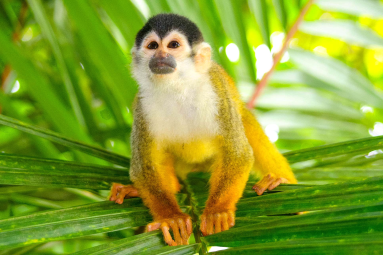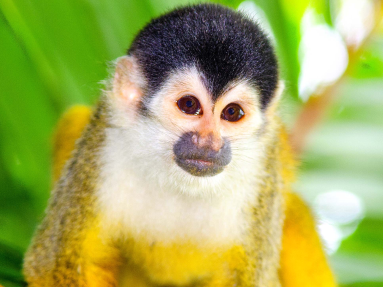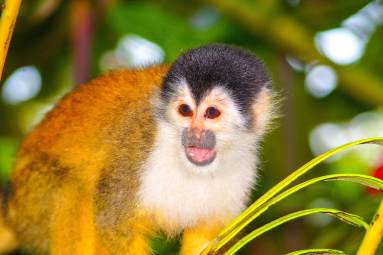Squirrel Monkeys
Highlights
- Scientific Name: Saimiri oerstedii
- Status in the Wild: Endangered
- Habitat: Rainforests
- Diet: Omnivore
The Central American squirrel monkey is the smallest of Costa Rica’s four primate species. Known locally as the mono titi, it is Central America’s most endangered monkey.
read more closeAlso referred to as the red-backed squirrel monkey, the primates are native to southwestern Costa Rica and northwestern Panama. They are characterized by small bodies – they grow to only two pounds – a white face with black cap, and a non-prehensile tail. They have an average lifespan of 20 years and are omnivores.Their diet is heavy on insects, insect larvae, small vertebrates (especially bats), fruits, flowers, nectar, and bark.
Due to their small size and endearing faces, squirrel monkeys were once popular on the exotic pet market. Between 1968 and 1972, an estimated 175,000 were sent to the United States for pet trade and biomedical research. In comparison, only 3,000 Central American squirrel monkeys are estimated alive today. Since exportation is now illegal, the greatest threat to these small primates is habitat loss.
Red-backed squirrel monkeys are very social animals – with troops averaging 20 to 70 individuals, they form the second largest-primate troop in the New World. (The largest troop size belongs to their southern cousins, the South American squirrel monkey, which form groups of over 100 individuals.) Unlike many New World monkeys, red-backed squirrel monkeys have an uncommon social arrangement: females, not males, leave their natal troops before the first breeding season, while males remain in the troop their entire lives.
Habitat:
Central American squirrel monkeys are found in mostly secondary or partially logged forests between sea level and 1,000 feet. In Costa Rica, there are two subspecies: Saimiri oerstedii oerstedii (black-crowned Central American squirrel monkey) and Saimiri oerstedii citrinellus (gray-crowned Central American squirrel monkey). The gray-crowned species is paler in color, and lives almost exclusively in Manuel Antonio National Park; the black-crowned squirrel monkey is found mostly in the Osa Peninsula’s Corcovado National Park.
Squirrel monkeys rarely descend to the ground, which means that fragmented forests isolate populations. Increased development has led to habitat loss and, since there are no biological corridors to allow the squirrel monkey to breed with other troops, populations are on the decline.
Reproduction:
Central American squirrel monkeys have a synchronized mating season, and most breeding occurs during September. Males often leave their own troops during mating season in search of females from other troops. Inter-troop mating is common, though it can cause problems between visiting and resident males.
Females generally begin reproducing at 2.5 years old, producing one baby per year during their most productive years, and one every other year later in life. Gestation lasts six months, so most squirrel monkeys are born in March. By the following March, most juveniles will be independent; after their second birthday, females will leave their natal troop, while the males will stay for life.
Status in the Wild:
Central American squirrel monkeys’ two subspecies are listed as endangered and critically endangered. Recent studies estimate that only 250 gray-crowned squirrel monkeys are left in Costa Rica’s Manuel Antonio National Park. The black-crowned subspecies inhabit Corcovado National Park, where populations are estimated at approximately 2,750. Several international organizations are involved in local conservation projects.
Squirrel Monkeys in Pictures
-

Endangered Squirrel Monkey Looking Up - Costa Rica
-

Squirrel Monkey Face Closeup - Costa Rica
-

Squirrel Monkey Corcovado - Costa Rica

